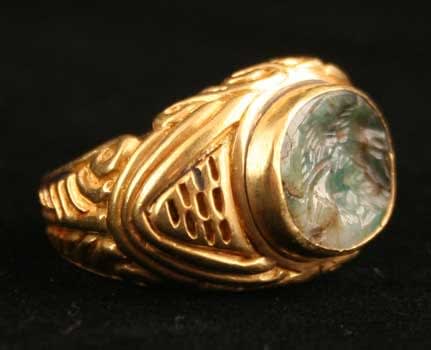Classical Revival Gold Ring Featuring a Roman Aventurine Seal of Alexander the Great, 100 CE - 300 CE
Gold and Aventurine
FJ.7257
This genuine Ancient Roman aventurine seal depicting Alexander the Great has been mounted in an antique Classical Revival 18 karat gold ring. The art of glyptics, or carving on colored...
This genuine Ancient Roman aventurine seal depicting Alexander the Great has been mounted in an antique Classical Revival 18 karat gold ring.
The art of glyptics, or carving on colored precious stones, is probably one of the oldest known to humanity. Intaglios, gems with an incised design, were made as early as the fourth and third millennia B.C. in Mesopotamia and the Aegean Islands. The exhibit a virtuosity of execution that suggests an old and stable tradition rooted in the earliest centuries. The tools required for carving gems were simple: a wheel with a belt-drive and a set of drills. Abrasives were necessary since the minerals used were too hard for a metal edge. A special difficulty of engraving intaglios, aside from their miniature size, was that the master had to work with a mirror-image in mind.
Alexander the Great, son of Philip II of Macedon, is arguably the most important historical figure in the ancient world. Born on July 20th, 356 BC, he was an astute, if somewhat headstrong student, and was schooled by various famous teachers, notably Aristotle. By the time of his death at the age of 32, he had personally supervised one of the largest land-based military expeditions of all time, and had conquered the whole of the then known world from Asia Minor across the whole of Persia, Anatolia, Syria, Phoenicia, Judea, Gaza, Egypt, Mesopotamia, Bactria, parts of India, Afghanistan and Pakistan. A legend in his own lifetime, he became known as much for his excesses and cruelty as his extraordinary military prowess but was nonetheless a comparatively fair and temperate man. Perhaps due to his supposed descent from Achilles and Herakles, he essentially became deified during the Hellenistic period. The Greeks celebrated Alexander in art and song, and his legend continued under the Romans, who had a fascination with military campaigns and tactics.
The art of glyptics, or carving on colored precious stones, is probably one of the oldest known to humanity. Intaglios, gems with an incised design, were made as early as the fourth and third millennia B.C. in Mesopotamia and the Aegean Islands. The exhibit a virtuosity of execution that suggests an old and stable tradition rooted in the earliest centuries. The tools required for carving gems were simple: a wheel with a belt-drive and a set of drills. Abrasives were necessary since the minerals used were too hard for a metal edge. A special difficulty of engraving intaglios, aside from their miniature size, was that the master had to work with a mirror-image in mind.
Alexander the Great, son of Philip II of Macedon, is arguably the most important historical figure in the ancient world. Born on July 20th, 356 BC, he was an astute, if somewhat headstrong student, and was schooled by various famous teachers, notably Aristotle. By the time of his death at the age of 32, he had personally supervised one of the largest land-based military expeditions of all time, and had conquered the whole of the then known world from Asia Minor across the whole of Persia, Anatolia, Syria, Phoenicia, Judea, Gaza, Egypt, Mesopotamia, Bactria, parts of India, Afghanistan and Pakistan. A legend in his own lifetime, he became known as much for his excesses and cruelty as his extraordinary military prowess but was nonetheless a comparatively fair and temperate man. Perhaps due to his supposed descent from Achilles and Herakles, he essentially became deified during the Hellenistic period. The Greeks celebrated Alexander in art and song, and his legend continued under the Romans, who had a fascination with military campaigns and tactics.



